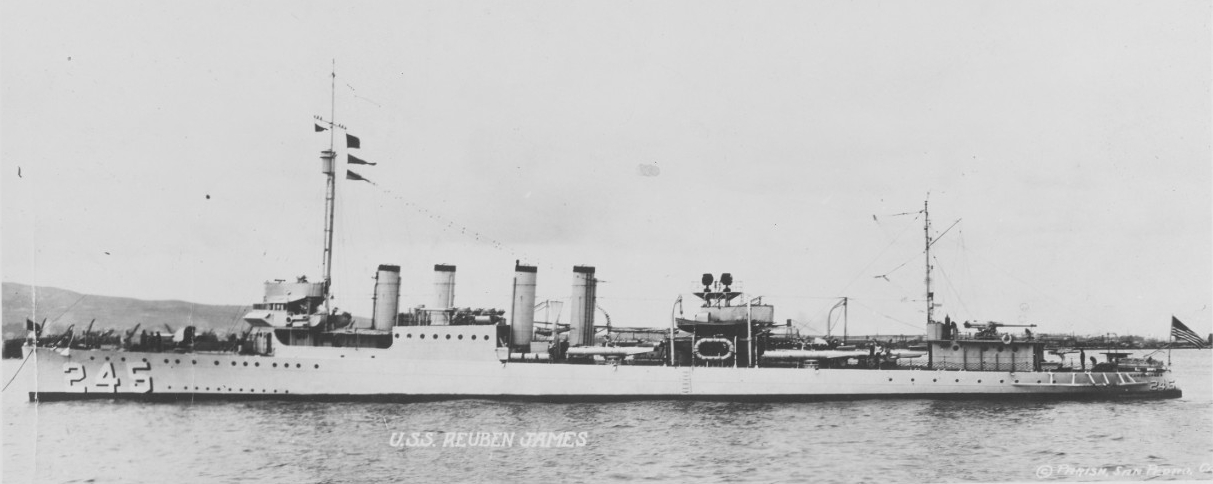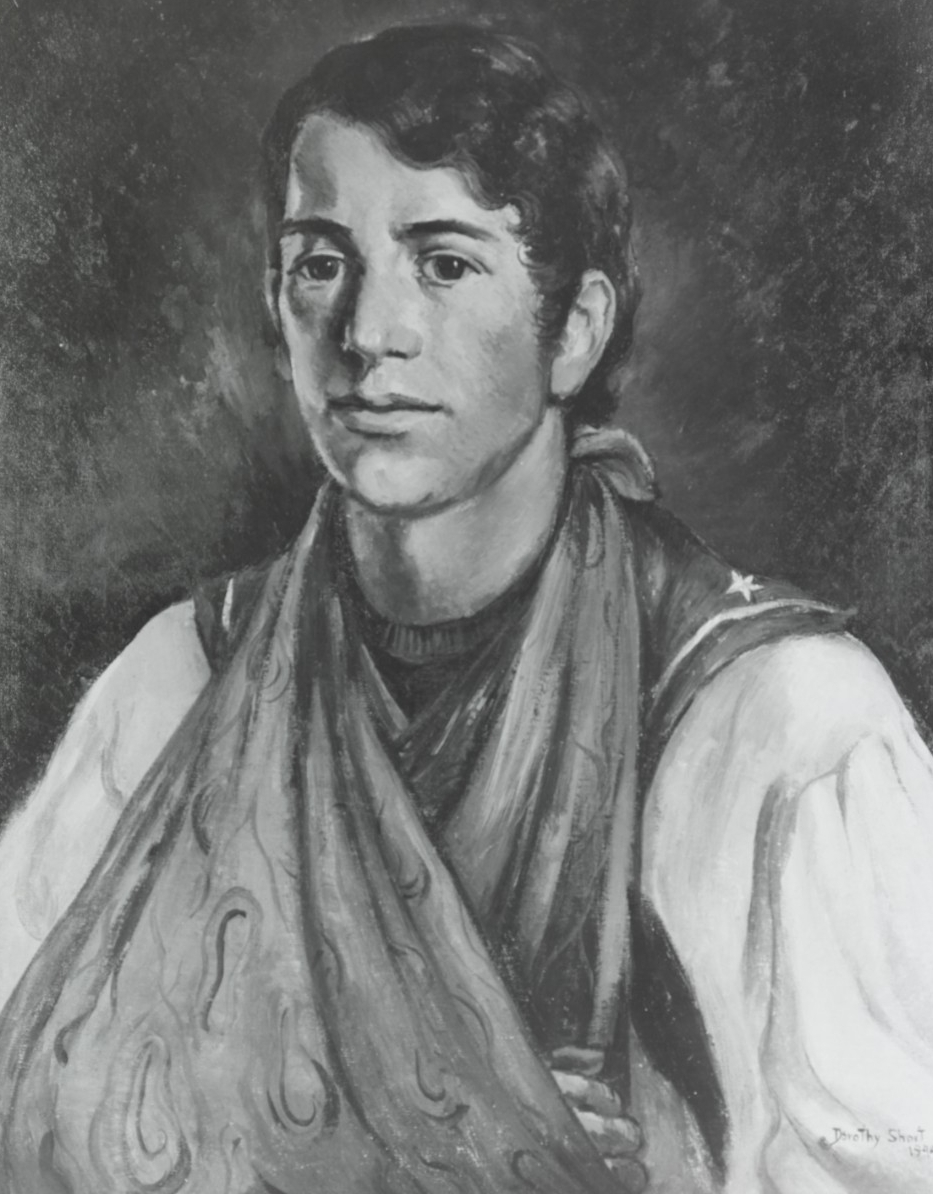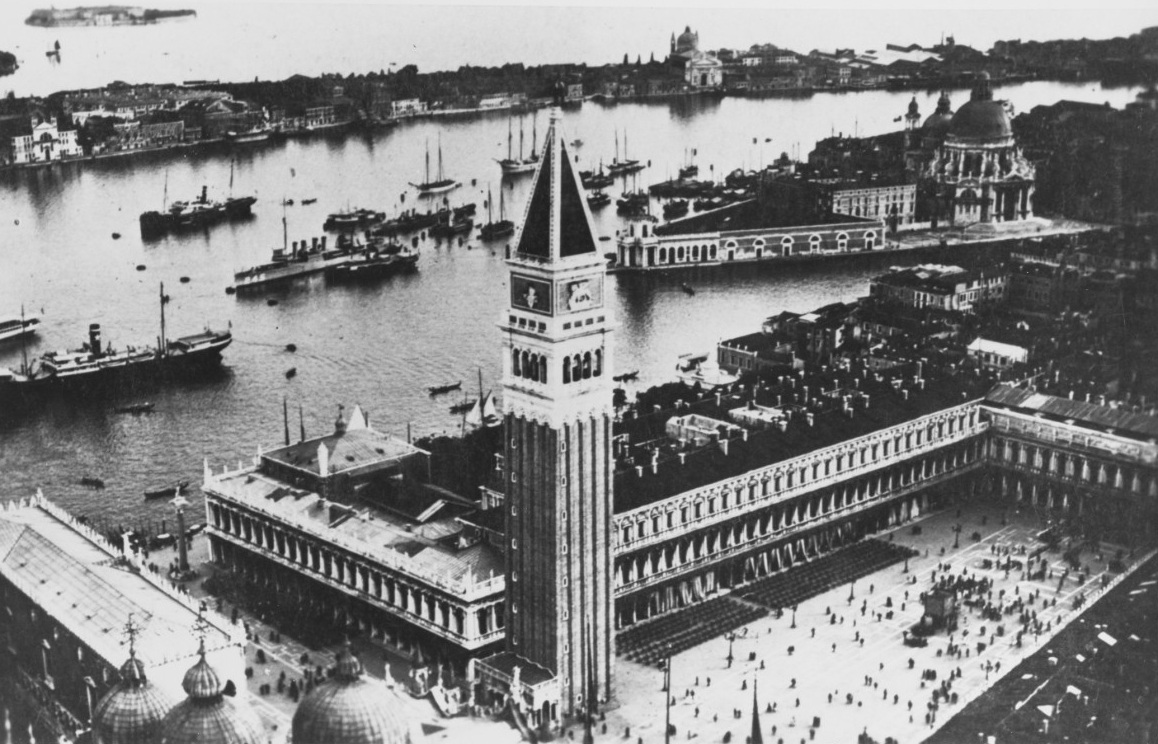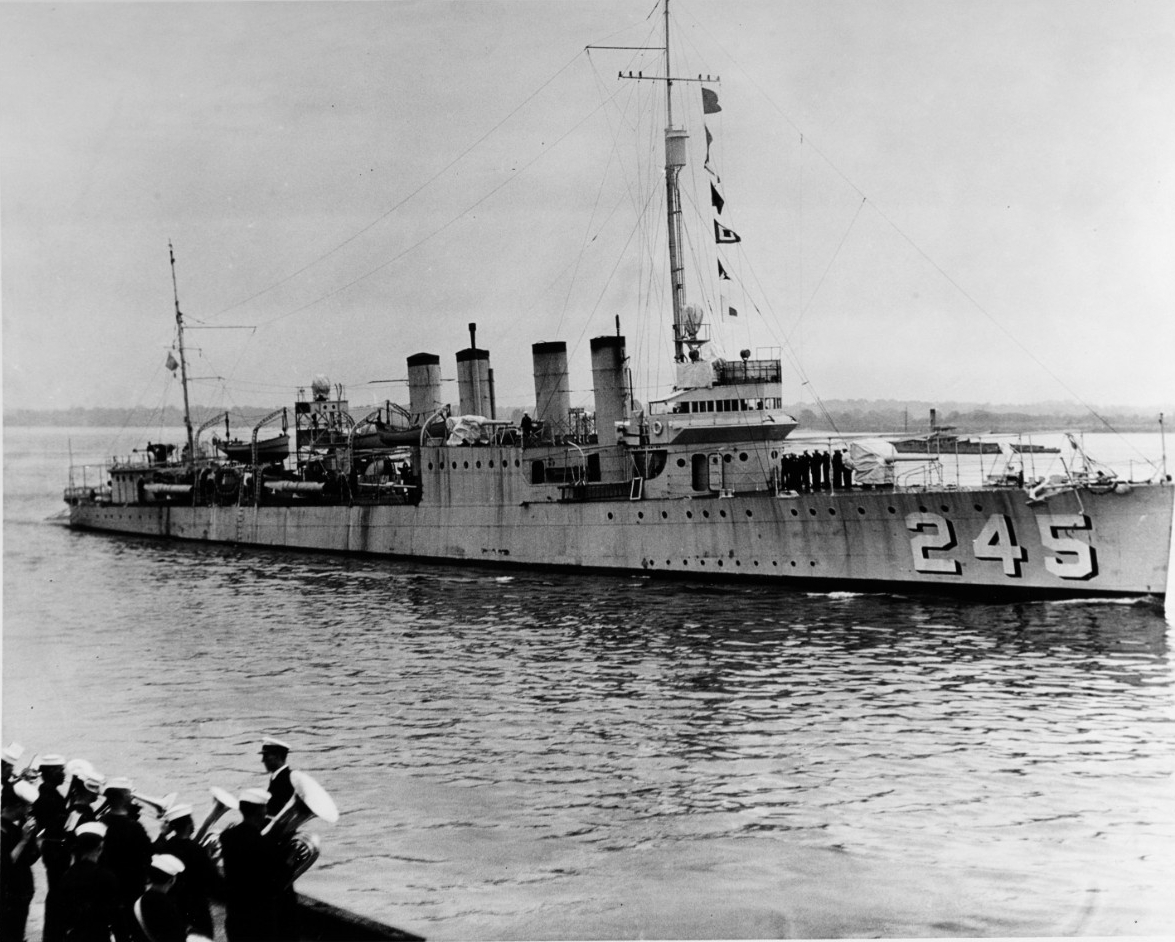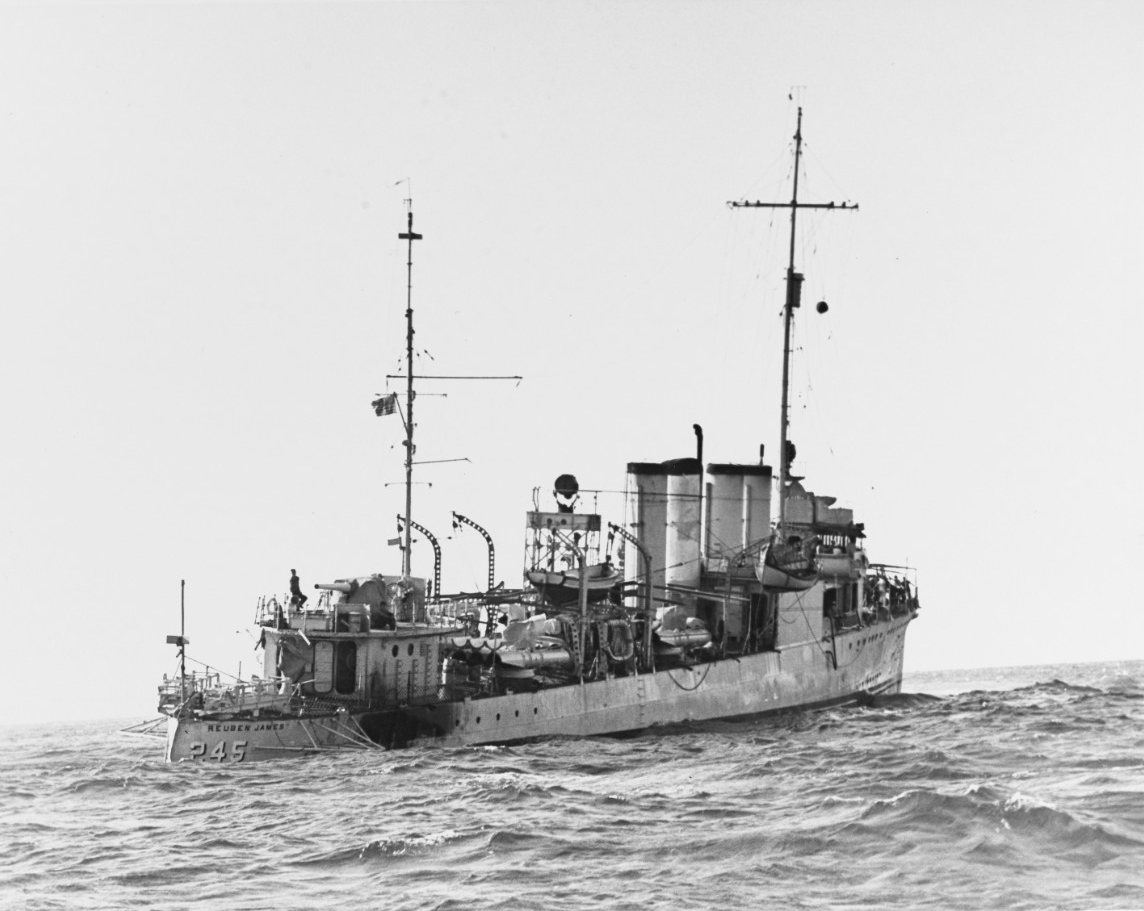Reuben James I (DD-245)
1920-1942
Reuben James was born in Delaware about 1776. During the Quasi-War with France, Boatswain's Mate James participated in Constellation’s victories over the French ships L'Insurgente, 9 February 1799, and La Vengeance.
During the Barbary Wars, James served in Enterprise and accompanied Stephen Decatur into the harbor at Tripoli on 16 February 1804, as Decatur and his men burned the captured American frigate Philadelphia to prevent the Tripolitans from using her in battle. In the ensuing skirmish, an American seaman positioned himself between Decatur and an enemy blade, an act of bravery attributed to Reuben James and to Daniel Frazier.
For the rest of the war, James continued to serve Decatur on board Constitution and Congress. During the War of 1812, he served in United States, under Decatur, and in President. On 15 January 1815, however, President was defeated by the British and James was taken prisoner.
After the war, he resumed service with Decatur, on board Guerriere, and participated in the capture of the 46-gun Algerian flagship Mashouda on 17 June 1815. After peace was made with the Barbary states, James continued his service in the Navy until declining health brought about his retirement in January 1836. He died on 3 December 1838 at the U.S. Naval Hospital in Washington, D.C.
I
(DD-245: displacement 1,215; length 314'5"; beam 31'8"; draft 9'4"; speed 35 knots; complement 101; armament 4 4-inch, 1 3-inch, 2 .30 caliber machine guns,12 21-inch torpedo tubes; class Clemson)
The unnamed Destroyer No. 245 was laid down on 2 April 1919 at Camden, N.J., by the New York Shipbuilding Corp.; named Reuben James in General Order No. 505 on 25 September 1919; launched on 4 October 1919; sponsored by Miss Helen Livingston Strauss, daughter of Rear Adm. Joseph Strauss; reclassified to DD-245 on 17 July 1920; and commissioned on 24 September 1920, Cmdr. Gordon W. Haines in command.
Intially assigned to Flotilla Three, Squadron Two, Division Forty-one, of the Destroyer Force, Atlantic Fleet, Reuben James sailed from Newport, R.I., on 30 November 1920 to Zelenika, Yugoslavia, arriving on 18 December. During the spring and summer of 1921, assigned to the Destroyer Detachment. Naval Forces in European Waters, she operated in the Adriatic and the Mediterranean out of Zelenika and Gravosa [Gruz], Yugoslavia, conducting patrols, assisting refugees and participating in investigations of conditions at numerous ports along the coast of the Adriatic. She carried U.S. Ambassador to Italy Raymond W. Child from Naples to Venice in September 1921, along with military, naval, and commercial attaches, visiting eight ports. She then put in to Spalato, where she assisted the collier Mars (AC-6), in closing down the naval supply base there and where Reuben James’s crew participated in the ceremonies turning over Tug No. 60 to the Yugoslavian Navy. She departed Spalato on 29 September, her sailing completing the withdrawal of U.S. naval vessels from the Adriatic, the U.S. Navy having “aid[ed] all nationals alike in that much-harried region and signally relieving the sufferings of the Russian refugees from the Crimea.”
Reuben James set course for Cherbourg, France, where she embarked Vice Adm. Albert P. Niblack, on 12 October 1921, the admiral having learned “that the British had decided rather hastily to have the ceremony [concerning the bestowal of a medal of honor on the “Unknown Warrior”] before the sailing of Gen. [John J.] Pershing…originally fixed for October 15.” The destroyer transported Vice Adm. Niblack to Portsmouth, England, whence the admiral proceeded to London, England. There he conferred with U.S. Ambassador to the United Kingdom George B. McC. Harvey. After Niblack had discussed U.S. naval participation in the London ceremonies with the First Sea Lord, Admiral of the Fleet Sir David Beatty, soon thereafter, he asked, with Ambassador Harvey’s consent, the commanding officer of the heavy cruiser Olympia (CA-15), then at Plymouth, to send a detachment of “50 men under arms and 3 officers” to represent the U.S. Navy on the occasion on 17 October. Subsequently, Niblack provided the destroyer Sands (DD-243) to transport General Pershing back to France.
While in London, Niblack took Cmdr. Rufus Z. Zogbaum, Jr., Reuben James’s commanding officer, to the American Relief Administration’s headquarters, where they learned of the Soviet government’s cooperation in sending foodstuffs into the heart of Russia, to relieve the suffering of Soviet children. Zogbaum also “took advantage of Commander A[ndrew] S. Hickey [from the Office of the U.S. Naval Attaché in Paris]…being in London” and discussed “the question of communications with the Relief Association so that there is a complete understanding of just what the Reuben James might have to do in case of a breakdown in communications.” As Niblack later reported: “It does not look as if there would be any political complications on account of the food relief, or on account of the food relief, or on account of the Reuben James being in the Baltic at Riga or Libau.”
On 20 October 1921, Reuben James proceeded to LeHavre, France, where she joined Olympia at ceremonies attending the departure of the body of the Unknown Soldier for the soil of his homeland. She then sailed for the Baltic, and at Danzig, Poland (29 October 1921-3 February 1922), Reuben James provided assistance for the American Relief Administration in its efforts to relieve hunger and misery in the wake of the Great War. After further duty in the Mediterranean, she departed Gibraltar on 17 July 1922, bound for New York.
Reuben James’s activities assumed a pattern in the 1920s, of active operations punctuated with port visits and overhauls, repairs and alterations part and parcel of a warship’s life. As an example, Reuben James embarked members of the USNR’s Sixteenth Division, Fourth Battalion, Third Naval District, at Whitestone Landing, Long Island, N.Y., on 3 July 1926, and set course for Nantucket, Mass., where she arrived on Independence Day. There, her baseball team played a local nine in one game. Sailing on 6 July, the destroyer joined the Fourteenth Squadron, U.S. Scouting Fleet, in Napeague Bay, Long Island, and participated in exercises with other destroyers in the waters off Block Island and Newport, R.I. (7-16 July) punctuating those training evolutions with a weekend (10-12 July) at Newport. Debarking the reservists back at Whitestone Landing on 17 July after their two-week indoctrination, Reuben James steamed to the Philadelphia Navy Yard where she served as an “exhibition destroyer” for the Navy at the Sesqui-Centennial Exposition there (18-31 July).
After spending August and September 1926 at the New York Navy Yard receiving her annual overhaul, Reuben James cleared the Navy Yard on 2 October 1926, then engaged in exercises with the U.S. Lines’ steamship Leviathan “in taking moving pictures for the Fox News Agency.” The destroyer then set course for Goinaives, Haiti, rejoining Destroyer Squadron Fourteen for autumn target practice and exercises (9 October-18 November), after which time she operated from Gonaives and Guantanamo.
Reuben James then steamed north, and after a four-day passage (18-22 November 1926), put in to the New York Navy Yard for a period of leave, liberty, and a ship’s force overhaul (22 November 1926-4 January 1927). At the conclusion of that time, Reuben James sailed on 5 January 1927 to fuel at Yorktown, Va., and then proceed to Guantanamo Bay. Three days later, however, a number of cases of influenza among her crew – as well as had occurred on board sister ship Lawrence (DD-250) – prompted the ship to arrive at Hampton Roads on 8 January to put the sick sailors ashore for treatment at the Norfolk Naval Hospital – Reuben James’ and Lawrence’s men having introduced a “particular epidemic strain of influenza” into the Naval Training Station as well as Naval Operating Base (NOB) Norfolk.
After remaining at Norfolk for a week, Reuben James sailed on 15 January 1927 to proceed to Gonaives to complete the annual gunnery exercises. The destroyer participated in training evolutions with other destroyers until 26 January, when she sailed for Panama. Transiting the isthmian waterway soon thereafter, Reuben James then operated in the Gulf of Fonseca, one of the five destroyers on temporary duty with the Special Service Squadron patrolling those waters to prevent gun-running activities during the insurrection in Nicaragua (30 January-15 March). Underway for Panama on 15 March, Reuben James spent a week at Balboa, then rejoined the Fourteenth Squadron on 26 March. She then participated in exercises during the U.S. Fleet’s concentration in the Caribbean (28 March-22 April), then proceeded to New York with the fleet for liberty (28 April-13 May).
After participating in Joint Army-Navy exercises in the Narragansett Bay area (13-22 May 1927), Reuben James spent the period from 22-28 May at Newport, then proceeded to Annapolis, then to the Southern Drill Grounds for exercises and training (28 May-17 June), returning to Annapolis for a ship’s force overhaul (17-23 June). Reuben James then wore the flag of Assistant Secretary of the Navy Theodore D. Robinson (24-27 June) during his visits to New London, Conn., and Poughkeepsie, N.Y. The destroyer then proceeded to the New York Navy Yard for repairs and an opportunity to provide leave and liberty (28 June-14 July), after which she sailed for Charleston, S.C., to embark another contingent of naval reservists. Such activities as those aforementioned continued through the end of the 1920s and into the next decade, but after an active life of over a decade, Reuben James was decommissioned at the Philadelphia Navy Yard on 20 January 1931.
Recommissioned at Philadelphia on 9 March 1932, Lt. Clement B. White in command, Reuben James again operated in the Atlantic and the Caribbean, as part of the Scouting Force. From September 1933 to January 1934 she patrolled Cuban waters during a period of revolution. Sailing for the Pacific from Norfolk on 19 October 1934, she arrived at her new homeport of San Diego, Calif., on 9 November. Reuben James operated off the west coast for the next half decade, participating in regular training evolutions punctuated with periodic overhauls and upkeep and port visits to “show the flag.”
Returning to the Atlantic Fleet (later the Atlantic Squadron) in January 1939, Reuben James operated from Philadelphia through that summer. On 29 August, she reported to the Chief of Naval Operations (CNO) for conversion to a small seaplane tender, AVP-16. Shortly afterward, however, on 1 September, hostilities began in Europe with the German invasion of Poland; that same day, the Office of the Chief of Naval Operations (OpNav) ordered Rear Adm. Alfred W. Johnson, Commander Atlantic Squadron, to establish, as soon as possible, a combined air and ship patrol to observe and report, in cipher, the movements of warships of warring nations, east from Boston along a line to 42°30'N, 65°00'W then south to 19°N, then around the seaward outline of the Windward and Leeward Islands, to the British island of Trinidad.
That same day [1 September 1939], Adm. Harold R. Stark, the CNO, directed Rear Adm. Johnson to maintain an offshore patrol to report "in confidential system" the movements of all foreign men-of-war approaching or leaving the east coast of the U.S. and approaching and entering or leaving the Caribbean. U.S. Navy ships were to avoid making a report of foreign men-of-war or suspicious craft, however, on making contact or when in their vicinity to avoid the performance of un-neutral service “or creating the impression that an un-neutral service is being performed.” The patrol was to extend about 300 miles off the eastern coastline of the United States and along the eastern boundary of the Caribbean.
U.S. naval vessels were also to report the presence of foreign warships sighted at sea to the district commandant concerned. Rear Adm. Johnson immediately began to establish the off-shore Neutrality Patrol, sending the small seaplane tenders Gannet (AVP-8) and Thrush (AVP-3) to San Juan, Puerto Rico, to establish a seaplane base there. On 11 September, the instructions to the Neutrality Patrol were modified to include covering the approaches to the Gulf of Mexico through the Yucatan Channel and the Straits of Florida.
On 12 September 1939, the CNO cancelled Reuben James’ conversion to an AVP (her place taken by George E. Badger) thus Commander Atlantic Squadron numbered her among the Neutrality Patrol assets, along with her sister ships Decatur (DD-341) and Barry (DD-248), and auxiliary [high speed transport] Manley (AG-28), with shore-based P2Y-2 flying boats of Patrol Squadrons (VP) 52 and 53, all to operate from Chesapeake Bay, with Norfolk as home port. The task group was designated as Patrol Three, and came under the command of Capt. William G. Greenman. Atlantic Squadron Operation Order No. 24-39 [16 October 1939], however, assigned Reuben James to the Key West Patrol (Lt. Cmdr. Harold R. Parker], basing at Key West, Fla. with Babbitt (DD-128), Claxton (DD-140) “and other destroyers to be added…”
Reuben James and Gilmer (DD-233) relieved Fairfax (DD-93) and Badger (DD-126) as plane guards for the aircraft carrier Ranger (CV-4) after she had recovered her air group on 28 October 1939 and set course for Guantanamo Bay, Cuba, the three ships reaching Cuban waters on 3 November. Subsequently, however, Reuben James ran aground in the Old Bahama Channel on 30 November 1939, off Lobos Cay, Cuba.
Ranger, en route for Havana, Cuba, to enable her crew “their first real liberty in five weeks,” altered course on hearing of her old consort’s grounding, and sped to her assistance, hoisting out her number one motor launch on the morning of 1 December 1939 and pumped oil into the waters surrounding Reuben James to form a slick. The carrier later removed three torpedoes, ammunition, and depth charges to lighten the destroyer, after which the salvage tug Warbler arrived on the scene, then still more ordnance later that day – the rest of her torpedo allowance, 128 rounds of 4-inch ammunition and more depth charges, after which the small seaplane tender Lapwing (AVP-1) reached the area to assist.
Suitably lightened, Reuben James floated free later that day [1 December 1939], and sailed for Charleston, S.C., in company with Ranger and Fox (DD-234). Gannet arrived later the same day and transferred Lt. Cmdr. William J. Murphy (CC), a salvage specialist, to Ranger, which transferred him to Reuben James to evaluate the destroyer’s damage the next morning. Eventually, the ships reached their destination on 5 December. Proceeding thence to the New York Navy Yard, Reuben James underwent repairs there and emerged on 3 June to rejoin the Atlantic Squadron at Newport later the same day. She returned to the New York Navy Yard within a fortnight, on 16 June, then returned to Newport on 11 July. After still another period at the New York yard (28 July-5 August), Reuben James stood in to Newport on 5 August, sailing for NOB Norfolk later the same day.
The destroyer reached Norfolk on 6 August 1940, remained there a little over a week, then sailed to return to New York Navy Yard on 14 August, arriving there the next day. Standing out of New York on 17 August, Reuben James set course for Guantanamo Bay, arriving there on schedule on 21 August. After visiting Santiago, Cuba (24-26 August), the ship returned to Guantanamo (26 August), sailing for New York later the same day, and arriving on the 30th. Departing New York on 7 September, Reuben James arrived on the Southern Drill Grounds the following day, carrying out exercises until setting course for Savannah, Ga., on the 13th. Following her visit to Savannah (14-16 September), the destroyer returned to the Southern Drill Grounds (17-19 September), after which time she sailed for New York; she made port the next day, then set course for NOB Norfolk soon thereafter, arriving on the 21st.
Reuben James stood out of Hampton Roads on 2 October 1940, and reached her destination on the 5th. Sailing for Savannah on the 23rd, she arrived two days later, and remained there until sailing for Annapolis on the 28th, making port on the 31st. Underway again on 5 November, Reuben James returned to NOB Norfolk on the 7th. The destroyer then sailed from Norfolk on 10 November and arrived at Houston, Texas, on the 15th, pushing on for the Panama Canal Zone four days later. Reaching her destination on the 24th, she sailed the following day for Key West, arriving on the 28th, getting underway for Charleston later the same day. Following that visit to that South Carolina port (30 November-8 December), Reuben James paused at Yorktown, Va. (9-11 December), shifted to NOB Norfolk (11 December), then stood out of Hampton Roads for Key West the following day. She reached her destination on the 18th, and remained there through Christmas of 1940.
On 1 March 1941, the Support Force, Atlantic Fleet (Rear Adm. Arthur LeR. Bristol), composed of destroyers and patrol plane squadrons, and supporting auxiliaries, was established for protection of convoys in North Atlantic; just ten days later [11 March 1941], the U.S. Congress passed the Lend-Lease Act, changing the “cash and carry” provisions of the 1939 Neutrality Act to permit transfer of munitions to Allies. Although criticized by isolationists, the Act proves to be the primary means by which the United States will provide Great Britain, the USSR, and other belligerents with war material, food, and financial aid without the U.S. having to enter combat. Initially, Task Force (TF) 4, as it was designated, was based at Narragansett Bay, with Reuben James one of the 18 “ODD” [old destroyers] assigned to the force. That unit would eventually guard convoys as far as Iceland, where they became the responsibility of the British.
Reuben James departed Newport on 17 May 1941 for the Philadelphia Navy Yard, making arrival there the next day, where she remained for a week. Sailing on 25 May, she reached Newport on the 26th, then proceeded thence on 2 June for New London, arriving there on the 4th. She then departed New London to return to Newport on 6 June, arriving there later the same day. Steaming to Argentia, Newfoundland, she then departed that place on 12 July, and reached Newport on 16 July. She sailed from Newport for Casco Bay, Maine, on 21 August, and arrived the next day. She got underway for Iceland on 6 September.
As Task Force (TF) 15 steamed toward its destination, Truxtun (DD-229), in the sound screen, with MacLeish (DD-220) abeam to starboard, and Reuben James, albeit with an inoperative gyro, maintaining her position 300 yards on her port quarter, sighted a surfaced submarine emerging from the fog. The boat immediately crash-dived. Truxtun, MacLeish, and Sampson (DD-394) all conducted depth charge attacks, dropping charges from their stern tracks and firing them from Y-guns, but with no evidence of any success. The force reached Hvalfjordur without further incident on the 16th.
Reuben James returned to Casco Bay, then cleared that body of water on 19 October 1941, reaching Argentia on 21 October. Two days later, on 23 October, Reuben James sailed from Argentia along with Niblack (DD-424), Hilary P. Jones (DD-427), Benson (DD-421) and Tarbell (DD-142), to escort the 44 ships of eastbound convoy HX-156, taking station on the 24th. The next day [25 October], Hilary P. Jones stood toward a contact on the convoy’s port side and fired one depth charge from her Y-gun but ceased fire soon after she sighted a school of porpoises under the bow. The same destroyer, on 29 October, picked up an echo on convoy’s port bow at 0910, 1,800 yards distant. Hilary P. Jones closed and carried out an embarrassing attack at 20 knots, dropping three 600-pound depth charges. After losing the contact, however, she rejoined the formation at 0930. The next day [30 October], Reuben James “made a good contact” on what was believed to be a submarine and released two charges. Ens. Craig Spowers, Reuben James’s depth charge officer, had the port charge on the Y-gun set at 150 feet, the starboard one at 200; he ordered two additional charges readied, the starboard for 150 feet and the port for 100.
At roughly 0534 on 31 October 1941, the German submarine U-552, Kapitänleutnant Erich Topp, commanding, less than a week out of St. Nazaire, France, on her sixth war patrol, fired two torpedoes that punched into Reuben James’s port side as the destroyer steamed at roughly 8.8 knots in her night cruising position on the port quarter of HX-156. “One or more explosions,” occurred in the vicinity of the forward fireroom, “accompanied by a lurid orange flame and a high column of black smoke visible for several minutes at some miles.”
The forward part of the ship open to the sea, Reuben James began to sink immediately, men emerging topside, aft, seeing nothing forward of number four stack within minutes of the explosions. Only F3c Parmie G. Appleton, the helmsman, and Cox. Gerald J. Delisle, the boatswain’s mate of the watch, survived the blast forward. The other survivors comprised men “berthed, or on watch, abaft the forward fireroom.”
Her generators stopped, then auxiliary lights came on, only to go out soon thereafter, with no formal order to abandon ship, Reuben James’s sailors managed to launch three rafts and leapt overboard as the ship settled into the sea. Her commanding officer’s having issued all hands lifejackets and told them to have them with them at all times meant that many of the survivors, even in a short time, had them nearby. When the after part of the ship slipped into the sea, at least two depth charges exploded, killing or drowning an undetermined number of men in the heavy oil slick that had formed.
When apprised of the explosion, Cmdr. Richard E. Webb, the escort commander, in Benson, contacted each destroyer and discovered that Reuben James was unaccounted-for. Webb immediately directed Niblack, astern of the convoy, and Hilary P. Jones, near the head of the port column of HX-156, to investigate. Providentially, a smooth sea and a gentle wind favored recovery, and Niblack spotted men in the water at 0555 and began rescue operations five minutes later, with Lt. George C. Seay (Niblack's executive officer), Ensigns John H. Rosenwald (USNR), David F. Polatty, Jr., and Samuel T. Orme (USNR), CCStd J. Cozy, BM1c F. T. Peterson, MM1c N. W. Daigneau, BM2c E. V. Robetts, and GM3c D. T. Berry going over the side and entering the water to help the struggling oil-covered survivors, during the exhausting work utilizing cargo nets, Jacob’s Ladders, life rings, and lines. Hilary P. Jones circled to provide protection for the work as her sistership rescued 36 men.
Both destroyers picked up good sound contacts dead astern, however, at 0708, forcing Niblack to suspend rescue operations. The ships exchanged stations, with Hilary P. Jones resuming the rescue work, taking on board 10 men and the body of F1c Windell H. Merrell, who had died of multiple injuries.
With rescue operations completed by 0805, the two destroyers investigated the status of two straggling merchantmen about four miles from the scene of Reuben James’s sinking, with Niblack rejoining the convoy. Hilary P. Jones rejoined the convoy at noon, after having guarded the stragglers and kept any U-boats down. She continued the search for survivors, but found none. Sadly, one of the men retrieved by Niblack, F3c Donald E. Olmstead, succumbed to his injuries on 2 November 1941.
All seven of Reuben James’s officers, including 35-year old Lt. Cmdr. Heywood L. Edwards, the commanding officer, and 93 enlisted men died in the loss of the ship (total fatalities: 100); 44 men survived (a number that included RM3c Kenneth C. Oaks, the sole passenger), CMM (AA) William H. Bergstresser was the senior enlisted man recovered.
Reuben James, the first U.S. Navy ship sunk by enemy action in World War II, was stricken from the Navy Register on 25 March 1942.
Commanding Officers Date Assumed Command
Cmdr. Gordon W. Haines 24 September 1920
Cmdr. Rufus Z. Zogbaum, Jr. 31 May 1921
Lt. Cmdr. George B. Ashe 1 October 1922
Cmdr. Gilbert J. Rowcliff 31 December 1922
Lt. Cmdr. James C. Byrnes, Jr. 11 February 1923
Cmdr. William S. Farber 4 August 1925
Lt. Cmdr. Stanley R. Canine 6 August 1927
Lt. Cmdr. Archer E. King, Jr. 12 June 1930
Lt. Clement B. White 9 March 1932
Lt. Cmdr. Nicholas Vytlactil 1 June 1934
Lt. Cmdr. William M. Callaghan 15 June 1936
Lt. Cmdr. Edward C. Metcalf 5 March 1938
Lt. Cmdr. Robert P. Wadell 22 April 1939
Lt. Cmdr. Earl V. Sherman 31 August 1939
Lt. (j.g.) Dewey G. Johnston 15 March 1940
Lt. Heywood L. Edwards 6 April 1940
Robert J. Cressman
26 October 2016

